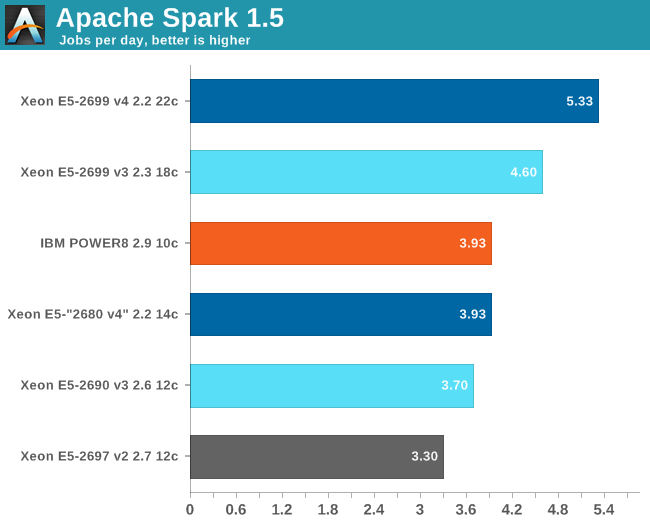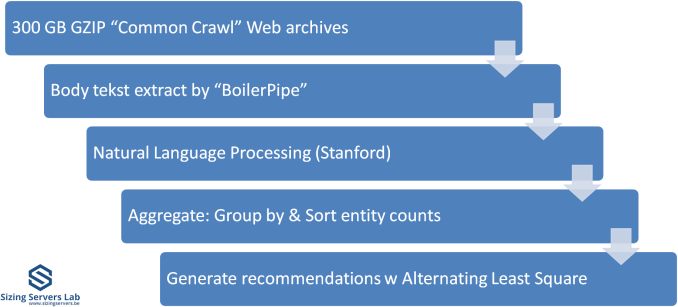Assessing IBM's POWER8, Part 2: Server Applications on OpenPOWER
by Johan De Gelas on September 15, 2016 8:01 AM ESTSpark Benchmarking
Spark is wonderful framework, but you need some decent input data and some good coding skills to really test it. Speeding up Big Data applications is the top priority project at the lab I work for (Sizing Servers Lab of the University College of West-Flanders), so I was able to turn to the coding skills of Wannes De Smet to produce a benchmark that uses many of the Spark features and is based upon real world usage.
The test is described in the graph above. We first start with 300 GB of compressed data gathered from the CommonCrawl. These compressed files are a large amount of web archives. We decompress the data on the fly to avoid a long wait that is mostly storage related. We then extract the meaningful text data out of the archives by using the Java library "BoilerPipe". Using the Stanford CoreNLP Natural Language Processing Toolkit, we extract entities ("words that mean something") out of the text, and then count which URLs have the highest occurrence of these entities. The Alternating Least Square algorithm is then used to recommend which URLs are the most interesting for a certain subject.
We tested with Apache Spark 1.5 in standalone mode (non-clustered) as it took us a long time to make sure that the results were repetitive. For now, we keep version 1.5 to be able to compare with earlier results.

The POWER8 surprises here with excellent performance: it is able to keep with a 14 core Xeon E5 "Broadwell EP" and beats the midrange Xeon E5-2690 v3 by healthy margin. Remember, this is a midrange POWER8: there are SKUs that reach 3.4-3.8 GHz.











49 Comments
View All Comments
loa - Monday, September 19, 2016 - link
This article neglects one important aspect to costs:per-core licensed software.
Those licenses can easily be north of 10 000$ . PER CORE. For some special purpose software the license cost can be over 100 000 $ / core. Yes, per core. It sounds ridiculous, but it's true.
So if your 10-core IBM system has the same performance as a 14-core Intel system, and your license cost is 10 000$ / core, well, then you just saved yourself 40 000 $ by using the IBM processor.
Even with lower license fee / core, the cost advantage can be significant, easily outweighing the additional electricity bill over the lifetime of the server.
aryonoco - Tuesday, September 20, 2016 - link
Thanks Johan for another very interesting article.As I have said before, there is literally nothing on the web that compares with your work. You are one of a kind!
Looking forward to POWER 9. Should be very interesting.
HellStew - Tuesday, September 20, 2016 - link
Good article as usually. Thanks Johan.I'd still love to see some VM benchmarks!
cdimauro - Wednesday, September 21, 2016 - link
I don't know how much value could have the performed tests, because they don't reflect what happens in the real world. In the real world you don't use an old o.s. version and an old compiler for an x86/x64 platform, only because the POWER platform has problems with the newer ones. And a company which spends so much money in setting up its systems, can also spend just a fraction and buy an Intel compiler to squeeze out the maximum performance.IMO you should perform the tests with the best environment(s) which is available for a specific platform.
JohanAnandtech - Sunday, September 25, 2016 - link
I missed your reaction, but we discussed this is in the first part. Using Intel's compiler is good practice in HPC, but it is not common at all in the rest of the server market. And I do not see what an Intel compiler can do when you install mysql or run java based applications. Nobody is running recompiled databases or most other server software.cdimauro - Sunday, October 2, 2016 - link
Then why you haven't used the latest available distro (and compiler) for x86? It's the one which people usually use when installing a brand new system.nils_ - Monday, September 26, 2016 - link
This seems rather disappointing, and with regards to optmized Postgres and MariaDB, I think in that case one should also build these software packages optimized for Xeon Broadwell.jesperfrimann - Thursday, September 29, 2016 - link
@nils_Optimized for.. simply means that the software has been officially ported to POWER, and yes that would normally include that the specific accelerators that are inside the POWER architecture now are actually used by the software, and this usually means changing the code a bit.
So .. to put it in other words .. just like it is with Intel x86 Xeons.
// Jesper
alpha754293 - Monday, October 3, 2016 - link
I look forward to your HPC benchmarks if/when they become available.